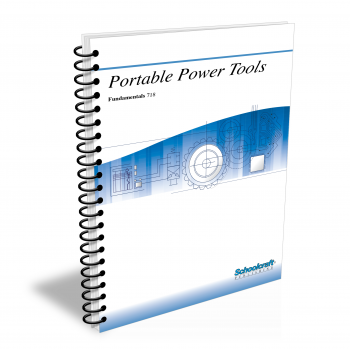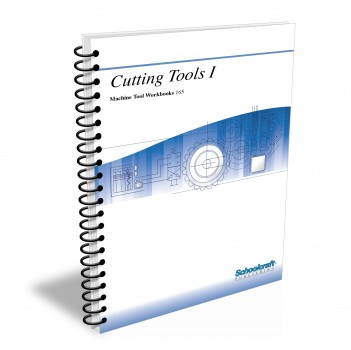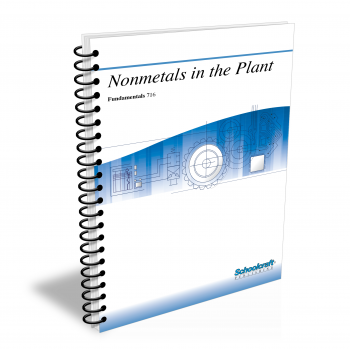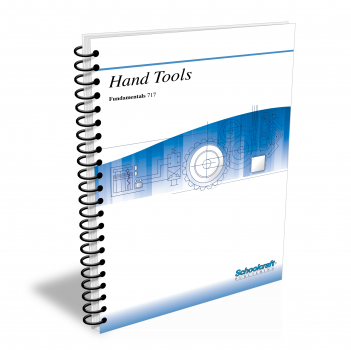Portable Power Tools

Course Number: 718
The Portable Power Tools textbook describes the basic handheld power tools used in many crafts. It makes an excellent companion to the 717 textbook on Hand Tools, in that it describes the powered equivalent of the same basic tools. The textbook is organized by the operating principles of the tools rather than by the functions of the tools in specific crafts. The final chapter describes how to sharpen tools of various kinds.
Does your curriculum require additional topics not included in this textbook? Build a customized version of the Portable Power Tools textbook below.
This textbook has been recently updated
to include topics lists, objectives, & key terms for every chapter.
Recommended Contact Hours – 15
Preview a Chapter
Available Supporting Material
- Table of Contents
- Exam Copies
- Suggested Titles
Table of Contents
Chapter 1: Electric Drills
Topics: Construction; Light- and heavy-duty drills; Accessories; Drill sizes and bits; Use and maintenance; Safety
Learning Objectives:
- Name four parts that are common to both the light-duty drill and the heavy-duty drill.
- Name the parts of a drill bit.
- Explain how to drill a blind hole.
- Explain how to inspect a drill bit, both visually and through testing.
- List the safety rules to follow when using electric power tools.
Chapter 2: Electric Hammers
Topics: Operation; Bits and chisels; Self-drilling anchors; Mechanical, electrical, and environmental safety
Learning Objectives:
- Explain the difference in hammering action between a percussion hammer and a rotary hammer.
- Select the proper chisel to use for each of the following jobs: brick cleaning; general demolition work; edging, chipping, and channeling; and removing floor tile.
- List the precautions that should be taken to ensure electrical safety when using an electric hammer.
- Name two safety items to use when operating an electric hammer in damp or wet areas.
Chapter 3: Pneumatic Drills and Hammers
Topics: Drill types and sizes; Bits; Operation; Hammer types; Chipping and scaling; Star drilling; Riveting; Tampers; Needle scalers; Diggers; Maintenance
Learning Objectives:
- Explain how drill size is determined.
- Describe the chiseling action of a bull point chisel when it is used to clean masonry seams.
- Describe how to use a rivet buster.
- Explain drill speed requirements.
- Identify various types of drill bits used in pneumatic hammers.
Chapter 4: Screwdrivers, Nutrunners, and Wrenches
Topics: Screwdrivers and nutrunners; Clutch mechanisms; Power wrenches; Bits and sockets; Operating power screwdrivers and wrenches; Lubricators and moisture separators; Tool safety
Learning Objectives:
- Identify the operating advantages of pneumatic tools.
- Define stalling torque.
- Describe the clutch action of direct drive, positive drive, and adjustable torque drive.
- Explain how to install a bit in an electric screwdriver.
- Describe how to install multiple fasteners correctly in a circular pattern.
- List safety rules to follow when using power screwdrivers and wrenches.
- Describe the difference between pneumatic and electric nutrunners.
Chapter 5: Linear-Motion Saws
Topics: Straight-blade power saws; Saber saws and blades; Plunge and straight cutting; Cutting metals; Reciprocating saws and blades; Band saws
Learning Objectives:
- List other names for both the saber saw and the reciprocating saw.
- Describe the cutting action of a saber saw.
- Explain how to draw a saw blade with regular set teeth and one with wavy set teeth.
- Explain how to plunge cut a rectangular opening.
- List the types of band saw blades described in this Lesson and a few characteristics of each.
Chapter 6: Circular Saws
Topics: Circular Saws; Using the circular saw; Circular and special saw blades; Crosscutting; Ripping; Angular cutting; Plunge cutting; Notching and grooving; Cut-off wheels; Arbors and arbor adapters; Accessories; Safety rules
Learning Objectives:
- Name the major parts of a circular saw.
- Describe the cutting action of a circular saw.
- List the factors that determine feed speed.
- State the definition of an arbor.
- Identify different types of blades.
Chapter 7: Routers and Planes
Topics: Router characteristics; Collet chucks; Bits; Direction of feed; Grooves and dadoes; Rabbet cuts; Trim; Circular cuts; Plane characteristics; Safety
Learning Objectives:
- Discuss how to use a router.
- Name the major parts of a router.
- Explain how to use a router and bit.
- Identify a rabbeting joint, a straight joint, and a mortising joint.
- Explain how to adjust and use a power plane.
Chapter 8: Electric Sanders
Topics: Belt, pad, orbital, and oscillating sanders; Use and maintenance; Disk sanders; Safety
Learning Objectives:
- Explain how to install a sanding belt.
- Identify different types of sanding belts.
- Explain how to flush the gear chamber of a belt sander.
- Discuss the assembly of a sanding disk.
- List the safety rules to follow when using a disk sander.
Chapter 9: Grinders and Shears
Topics: Grinder selection; Wheel classification; Mounting grinding wheels; Maintenance; Safety; Shears and nibblers selection and use
Learning Objectives:
- State the meaning of each symbol in the six-symbol standard marking system for grinding wheels.
- Explain the correct procedure for mounting a grinding wheel.
- List safety rules to follow when using a grinder.
- Discuss how to maintain grinders.
Chapter 10: Tool Sharpening
Topics: Whetstones; Using a bench grinder; Sharpening chisels, drill bits, screwdrivers, pointed tools, reamers, taps, and dies; Other methods
Learning Objectives:
- State the reasons for sharpening tools.
- Explain the use of whetstones
- Identify a bench stone.
- Explain how to sharpen taps, dies, screwdrivers, and chisels
Request Exam Copies
Exam Copies
Ready to see a copy of our textbooks? After selecting which textbooks you’d like to review for your course, you can submit your request by either logging in or creating an account so we know where to ship your exam copies. A representative from Schoolcraft will contact you to confirm and finish processing your request.
Exam copies are always free and yours to keep.
Selected Exam Copies
none selected
* Maximum of five copies can be ordered




